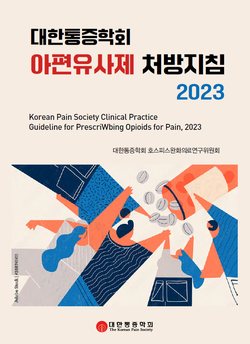As addiction to narcotic painkillers (opioids) has become a social problem, doctors are faced with the challenge of prescribing them to patients who really need them.

Against this backdrop, the Korean Pain Society has released guidelines for prescribing opioids adapted to Korean medical realities.
The society unveiled the “Opioid Prescribing Guidelines 2023” at its 76th congress at the Swiss Grand Hotel Convention Center in Seoul last Saturday. It operated a team over the past year to develop the new guidelines by referring to relevant guidelines worldwide, including the U.S., and tailoring them to Korean medical realities.
The guidelines stated that before prescribing opioids, physicians should accurately identify the cause and nature of the pain through history taking and examination and checking past treatment methods and medication history, including interventional treatment methods.
Proper dosing is also important. The dose of narcotic analgesics is measured in terms of the effect per milligram (mg) of morphine, called the "morphine milligram equivalent" (MME).

The guidelines also emphasized that prescribing opioids should not be the first choice when treating patients.
However, for severe acute pain lasting less than one month, a short-acting oral opioid should be prescribed at the lowest effective dose and for no longer than the expected duration of pain. For subacute (one to three months) and chronic (three months or more) non-cancer pain, non-opioid medications should be prioritized.
For patients without opioid-taking experiences, the minimum starting dose is a single 5-10 MME dose or 20-30 MME per day, adjusted for pain severity and other factors such as renal or hepatic insufficiency.
They also cautioned against increasing or decreasing opioids and switching to another type of opioid.
For subacute or chronic patients requiring continuous opioid use, they recommended avoiding further dose escalation beyond 50 MME per day. After a dose increase, reassess the benefits and risks of continued opioid therapy in one to four weeks.
Abrupt discontinuation or rapid tapering from high doses should be avoided unless there are signs associated with an overdose, such as confusion, sedation, or slurred speech, according to the guidelines. For patients who are dependent on opioids, reducing or abruptly stopping the dose can lead to acute withdrawal symptoms, worsening pain, and suicidal ideation.
Therefore, guidelines called for tapering them slowly.
How patients taper depends on how long they've been taking the drug.
If the patients have been taking opioids for more than a year, the guidelines recommend slowly tapering off 10 percent of their original dose for a month. If they’ve been taking opioids for a few weeks to a few months, tapering off 10 percent each week was recommended. If they've been taking opioids for acute pain for more than three days but less than a week, they recommend reducing the daily dose by 50 percent over two days and 20 percent if they've been using opioids for more than a week but less than a month.
Opioid rotation, which involves switching to a different type of opioid to improve analgesia and reduce side effects, is also possible, the guidelines said.
When substituting, the guideline recommends calculating the total amount of opioids currently being administered and the MME dose of the substituted medication, starting at 50 to 75 percent of the calculated dose and adjusting as side effects and analgesia are monitored.
The guidelines additionally stressed that when prescribing opioids, it is important to keep an eye out for combinations with overdose-prone medications. They emphasized that particular attention should be paid to concomitant prescribing of opioids with benzodiazepines or other central nervous system depressants.
Finally, the guidance made clear that it is a recommendation for prescribing opioids. It should not be used as a rigid, inflexible standard of care for patient care and is not a substitute for clinical judgment and individualized, patient-centered decision-making.
The Opioid TEN RULES condensed this guidance into ten provisions. They serve as a core set of guidelines that physicians can immediately refer to when prescribing opioids in the outpatient setting.
The companion CDC Clinical Practice Guideline for Prescribing Opioids for Patients with Pain summarizes the key findings of the CDC's last clinical practice guideline on opioid prescribing in 2022.
"Opioids are one of the ways we can help patients suffering from pain," said Dr. Lee Pyeong-bok, president of the Korean Pain Society. “Their ability to produce effects at higher doses and avoid dependence when properly titrated can be an important weapon of the medical professionals in treating pain patients."
Lee noted that the society’s 2018 survey found no evidence of an explosion in the number of dangerous opioid-related deaths or a flood of physician-prescribed addicts on the streets.
“Opioid prescriptions are on the rise, and we need to be vigilant,” he said. “We hope that safe and appropriate prescribing of opioids will be a step toward solving the drug problem."

